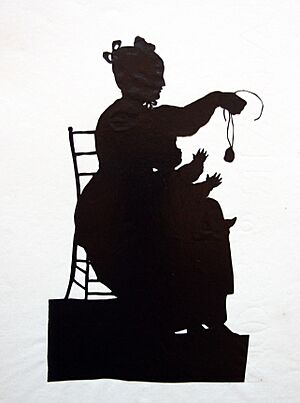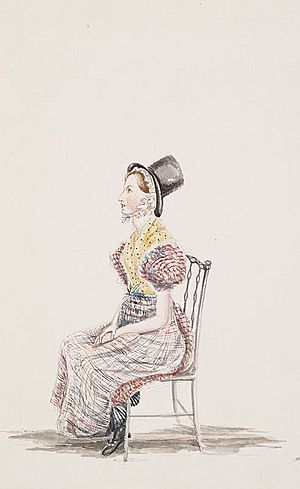Augusta Hall, Baroness Llanover facts for kids
Augusta Hall, Baroness Llanover (born Augusta Waddington on March 21, 1802 – died January 17, 1896), was an important Welsh woman. She inherited a lot of land and money, and she is best known for supporting Welsh culture and arts.
Contents
Growing Up in Wales
Augusta Waddington was born on March 12, 1802, near a town called Abergavenny in Wales. She was the youngest daughter of Benjamin Waddington and Georgina Port. Augusta grew up at the Llanover estate in Monmouthshire, which she would later inherit. Her mother taught Augusta and her sisters at home.
Marriage and Family Life
In 1823, Augusta married Benjamin Hall. Their marriage brought together two large estates in South Wales: Llanover and Abercarn.
Benjamin Hall was a Member of Parliament for Monmouth for some years. He later became a Baron, which meant he joined the House of Lords in 1859. He was known as Baron Llanover. Many people believe that "Big Ben", the famous bell at the Palace of Westminster in London, was named after him. This is because he was in charge of public works when it was built in 1855.
Building Llanover House
In 1828, Augusta and Benjamin asked an architect named Thomas Hopper to build Llanover House for them. They wanted it to be a family home, but also a place where Welsh arts and culture could be celebrated.
Lady Llanover was always very interested in Celtic Studies, which is the study of Celtic languages and cultures. Her older sister, Frances, had married a German diplomat named Baron Bunsen. Their homes in Rome and London were busy places where people interested in Celtic culture often met.
Supporting Welsh Culture
Lady Llanover was greatly inspired by a local Welsh poet and scholar named Thomas Price, also known as Carnhuanawc. She met him at a Welsh festival called an Eisteddfod in 1826. Carnhuanawc taught her the Welsh language. She loved it so much that she took a special Welsh name, "Gwenynen Gwent", which means 'the bee of Gwent'.
She became an early member of a group called Cymreigyddion y Fenni, which promoted the Welsh language. Even though her Welsh was not perfect, she was very enthusiastic about everything Welsh. At Llanover Hall, she organized her household based on what she believed were old Welsh traditions. She even gave her staff Welsh titles and had them wear Welsh costumes.
Her husband, Benjamin, also cared about keeping Welsh heritage alive. He worked to make sure that church services in Wales could be held in the Welsh language.
Promoting Welsh Costume
In 1834, Lady Llanover won a prize at the Cardiff Eisteddfod for her essay. It was about The Advantages resulting from the Preservation of the Welsh language and National Costume of Wales. This essay was published in both Welsh and English in 1836.
She likely asked for a series of watercolours to be painted. These pictures showed different Welsh costumes worn by women in south Wales and Cardiganshire. Thirteen of these were later made into prints. Lady Llanover wanted Welsh women to wear clothes made from local Welsh wool instead of cheap cotton. However, there is not much proof that her ideas changed how most Welsh people dressed. Her influence was mostly seen among her own family, friends, and servants.
She also encouraged the making of traditional striped and checked woollen cloth. She offered prizes at Eisteddfodau for good examples of these fabrics.
Other Contributions
In 1850, Lady Llanover helped start Y Gymraes ("The Welshwoman"). This was the first Welsh-language magazine specifically for women. She was also interested in cooking. She published a cookbook called The First Principles of Good Cookery in 1867.
She loved folk music and encouraged the use of the traditional Welsh triple harp. She even had a harpist living at Llanover Hall.
Lady Llanover supported many Welsh cultural projects. She helped the Welsh Manuscripts Society and funded a Welsh dictionary. She also bought many old Welsh manuscripts, which are now kept at the National Museum of Wales in Cardiff. She worked with Welsh musicians like Maria Jane Williams and Henry Brinley Richards, who wrote "God Bless the Prince of Wales". Lady Llanover herself created a Collection of Welsh Airs.
Her Later Years
Lady Llanover was a strong supporter of the temperance movement. This movement encouraged people to avoid alcoholic drinks. She closed all the pubs on her estate and sometimes opened a small, alcohol-free inn instead. She believed strongly in healthy living.
She lived for almost thirty years after her husband passed away, reaching her nineties. Only one of their daughters, Augusta, lived to adulthood. This daughter married Arthur Jones in 1846. Their eldest son, Ivor Herbert, 1st Baron Treowen, became a Member of Parliament and a Major-General.
|




